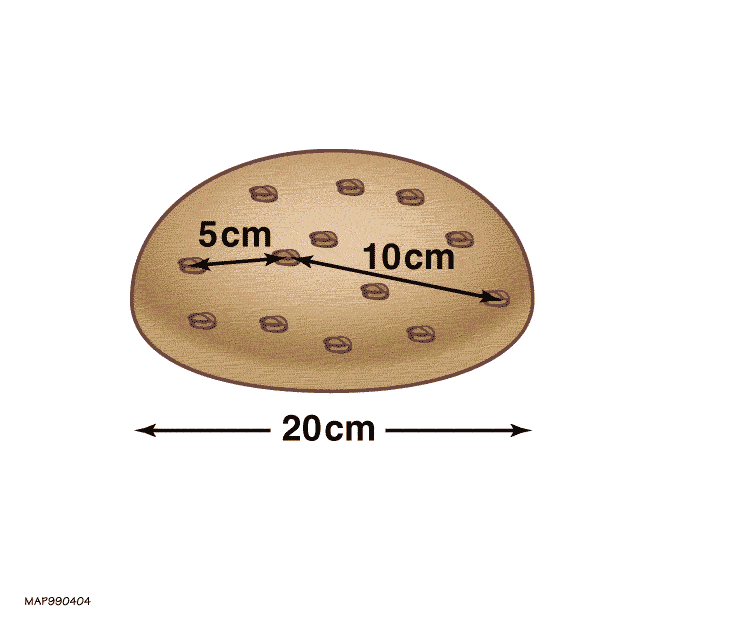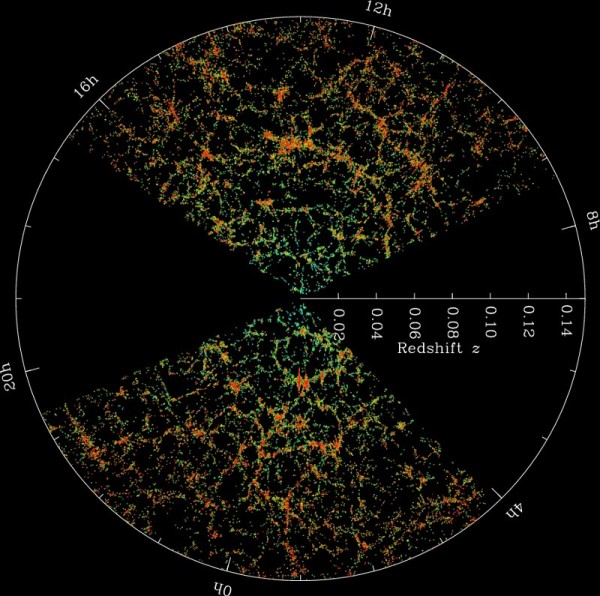When it comes to the Universe, physicists say things like: it originated in a Big Bang, it's isotropic (or the same in all directions), and it's homogeneous (the same everywhere), save for the effects of cosmic evolution. In every direction we look, we see galaxies expanding away from us, with the expansion rate increasing the farther away we look.
 Image credit: NASA / WMAP science team, via http://map.gsfc.nasa.gov/universe/bb_tests_exp.html.
Image credit: NASA / WMAP science team, via http://map.gsfc.nasa.gov/universe/bb_tests_exp.html.
But an expansion inherent to the fabric of space itself isn't the only explanation; it's conceivable that we see what we see because everything else in the Universe is speeding away from us, and that spacetime itself is static. But what does the Universe itself have to say about that?
Jillian Scudder takes this on for this week's Astroquizzical!
- Log in to post comments


What if the Earth is in a special location in the universe? What if space-time is not expanding?
In every direction we look, about 13.8 billion years ago there was a singularity. From the vantage point of Earth, we are the farthest possible distance from the Big Bang singularity. We are at the top of the hill with the Big Bang's gravity well in every direction we look.
If we were in a different galaxy a billion light years away, we'd see that galaxy as the special place at the top of the hill. Being as there is such a thing as gravitational red shift, how do we know space is expanding rather than light is being redshifted as it climbs up out of the Big Bang's gravity well towards us across static space?
You never answer it, though.
Why should the Earth be in a special location in the universe? Why should space-time NOT be expanding, since it appears it does?
And every person sees the horizon equidistant from themselves, that horizon being the furthest possible distance from that location. That means that everyone is in a special location on the earth!
Doesn't seem so special when everyone appears to have their own special location. Does it.
And there some denier would be asking what if the planet Bleurgh was in a special location in the universe? And they'd have just as accurate a "reason" for it.
Not so special when any old planet in any galaxy appears to have the same special location, is it?
Because that bit of the BB that is on the other side of us to where that light photon came from is pulling it up toward us (blueshifting) as much as the bit it just came from is pulling it down (redshifting).
How many times will you have to get this wrong before you realise you have something wrong?
Other problems. Elsewhere you insist that if space is expanding, it must be being created somewhere, but if that is happening at the edge of the universe, that is where WE are.
So all the new space should be created here where we sit.
Remember: that stuff at 13.8 Bn Ly away is at the centre of the big bang. The oldest stuff.
That is exactly my point. We don't have to be a freak of statistics or the product of divine planning. Everyone appears to have their own special location with everyone else being downhill from them.
You are thinking 3 dimensionally. There is no BB on the other side of us. All BB is 13.8 billion years behind and downhill from us.
In this hypothetical, there is no expanding space. Things are moving around in space, but space itself is not expanding.
Therefore there is NO special location. Everywhere has the same view. EVERYWHERE sees the same thing.
Yes. We live in a universe of three dimensions of space, and the reason why gravity falls off as a square of the distance inverted is because it reacts in 3 dimensions.
Yes there is. Go look the way the photon was traveling to before you got in the way. There's a BB view there, just like where the photon came from.
Yes, and? Prove your hypothetical first. Then we can see if it concludes that there is no expanding space.
For example, if there's no expansion, yet you admit to a gravitational force, why aren't we all smooshing together?
Nope. A photon coming from the BB and traveling in a straight line, if we were not in the way, would never continue on in its straight line path to reach the BB. The path of the photon is a straight line through 4 dimensions.
Dark Energy.
Yup.
Yes it would. Turn around and look that way. See a photon coming that way, 180 degrees from the way that other photon was going? Without your block head getting in the way, that photon will keep going past and continue on toward that BB place.
Uh, a geodesic. But three of those dimensions are space. It doesn't and cannot go "45 degrees west-by-six-o'clock".
Please find out what those four dimensions are. That fourth one isn't a space dimension, and a photon traveling through three dimensional space will continue going in the same "straight line" you describe in those three dimensions forward in time.
Oh, by the way, if the photon path isn't straight, then it isn't coming straight out of a gravity well, it has to be diverted by another gravity well "off to one side".
The first link I found on this, read it denier.
http://www.astro.ucla.edu/~wright/tiredlit.htm
The path of the photon is arrow straight. It just appears to us to bend because of the gravitational topology of the space-time it is traveling through.
Thank you for the link. Researching now.
Then it goes straight to the other side of the earth and continues on to the other side of the universe where there is a BB.
um. no. the photon may continue on to the heat death of the universe but it will never hit the big bang.
After doing some research, it turns out @Ethan has already written the article.
http://scienceblogs.com/startswithabang/2010/10/08/big-bang-alternative…
@Denier #14: Besides Ethan's always excellent writing, you may also want to read the Wikipedia article on "tired light," http://en.wikipedia.org/wiki/Tired_light .
It does a good job of going through the various incarnations of the idea (I wouldn't give it the benefit of "hypothesis" :-/), with pointers to the observation data which refutes each incarnation.
One really cool thing I learned from the article is that Fritz Zwicky (who first recognized the need for dark matter) first proposed "tired light" back in 1929, and spent the entire paper working through all of the observational evidence needed (or already existing!) to show that it was wrong. That's how good science is done.
You wrote, "[Denier wrote] "The path of the photon is a straight line through 4 dimensions." Uh, a geodesic. But three of those dimensions are space. It doesn’t and cannot go “45 degrees west-by-six-o’clock”."
Heh, heh. Unless of course you (someone) take those Minkowski diagrams a bit too literally. In which case the photon's null geodesic really _does_ go 45 degrees right of noon :-)
Um, wrong.
Like totally wrong.
Like, "where the hell did you pull that from" wrong.
Aye, reification has led to some of the most braindead "hypothesis" by woomancers and religiotards when they try to "prove" science wrong (and, by some ridiculous alchemy that therefore their one single unsupported answer is right without having to support it).
I was having some problem working out whether if this IS another half-assed attempt to describe tired light, though.
As usual, there was so little information on what was being said that it really requires a leap to conclude it was "tired light".
I do not agree with the sentence: "With every measurement that was taken of these spiral and elliptical “nebulae” in the skies, it became clear that each one appeared to be moving away from us."
Actually, what has Hubble mesured is that the galaxies _in avarage_ are red-shifted, but there were also blue-shifted galaxies. E.g. the Andromeda galaxy is moving toward us.
This average red shift was the basis for the conclusion that the Universe was expanding. If it were static, the average frequency shift would be zero.
Of course, Hubble mesured only the nearest galaxies. Galaxies that are far enough are actually all red-shifted.
As long as some of the usual non-science folks are posting foolishness here, this seems as good a spot as any to note that the web site against which all other editions of crankery were judged seems to have closed up shop: It appears the "time cube" site is gone.
http://www.theverge.com/2015/9/2/9247913/time-cube-is-gone?ref=fark
What are the estimates for how much universe may exist beyond the Hubble Sphere, and how are those estimates determined?
Does anyone have any interesting sources that offer competent and reasonable speculation?
Mando, that quetion was answered in a previous thread.
cliff notes (because I can't be arsed to do any more work than this) is that the level of isotropy in the CMB gives a lower bound estimate in the inflation required to turn a "normal sort of random CMB" into the "very smooth not really very random at all CMB" we see.
The difference is many orders of magnitudes.